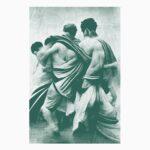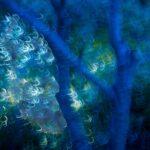YANN NOVAK – THE VOICE OF THESEUS 
For The Voice Of Theseus, Yann Novak invited vocalists Dorian Wood and G. Brenner to contribute to the core elements of this album. By adding their vocals to his compositions, and merging them with his electronic soundscapes, Novak explores a completely new compositional field, ‘expanding his mode of operation’.
Novak explores his perceptual differences, as he calls them, compared to other people: partial color blindness, dyslexia, and a more recently acquired tinnitus. ‘Sensory challenges that shaped my artistic practice by creating what I call a perceptual insecurity’:
‘If I have trouble perceiving reds and greens, if I have trouble hearing certain frequencies, if I don’t interpret written language in a standard way, how closely can I experience reality in the way that others experience it?’
The listener, on the other hand, will never know in which way the music hé hears may differ from how Novak himself experiences it. One thing is sure, however: it can never be the same.
The ancient Greek legend of Theseus raises a philosophical question: ‘if a ship is repaired, piece by piece, until it was no longer composed of any original parts, at what point could the ship no longer be considered the
same entity?’
The same can be applied to the manipulations of the recorded vocals in these pieces: ‘how far can these vocals
be pushed while still remaining attached to the vocalists’ identities?’
Questions that are impossible to answer: ‘There’s no real way to know how great the disparity is between my observational experiences and another’s, and no clear limit of how many pieces of our shared reality can be
altered—before it stops being just that.’
These are interesting things to ponder about while listening to The Voice Of Theseus, but it’s not necessary background information to fully enjoy the resulting music. There are tracks on which the voices of Wood and Brenner are used (almost) unaltered, most notably on the opening track A Monument To Oblivion. At other times, the vocals can hardly be recognized as such. The music is extremely atmospheric, with enigmatic undertones triggered by their titles which probably refer to different stages in the Theseus legend.
Edit July 2024: The Voice Of Theseus 2024 edition
As an addendum/companion to this album from July 2023, Yann Novak released a digital-only version with the same title in July 2024. This version contains three reworks of Traversing The Substrate, Super Coherent Light, and We Went Out, Not With A Whimper, But A Whisper with more emphasis on the voice of G. Brenner. It also included remixes from other tracks by Lawrence English, FAX, Bana Haffar, and Madeleine Cocolas.
It’s definitely worth checking out and comparing both releases!
SIAVASH AMINI – EIDOLON 
Iranian composer Siavash Amini‘s music is described as ‘vertical’, which means it is based on simultaneous sounding tones (chords), as opposed to ‘horizontal’ which is based on successively sounding tones (melody).
As a ‘self confessed tuning obsessive’, he wanted to explore the 17-tone scale described by Safi-al-din Urmavi in the 13th century. But not with conventional instruments and composition techniques and not in a historical sense.
Using contemporary techniques of experimental and electronic music he creates an ‘undetermined sound space’ by ‘letting their frequencies and intervals roll over each other, and letting the resulting sound and textures float, crash, spill and bleed.’
In that ‘undetermined space’ of these three intense soundscapes, an apparition may appear (Eidolon means phantom, or apparition), ‘taking shape in an instant and gone in the next, something you’re not sure you’ve seen.’
ARIA ROSTAMI – SIREN 
The use of field recordings combined with ambient music is anything but new. But on his latest album Siren, Brooklyn-based Aria Rostami takes it to a different level.
He uses ‘literal’ field recordings, but combines them with ‘composed musical emulations of environments’: by taking field recordings from recordings of field recordings playing in his studio. Or by recording the piano parts with a field recorder (are you still here?).
Field recordings, recordings of field recordings, and field recordings of playing musical instruments are then blended ‘into an undefined grey area’. Which, to my ears, is not particularly ‘grey’, but very pleasing. Even if some of the environments sound quite ‘busy’ (as they can do in real life of course).
After releasing his music since 2011 on various different labels, this (20th?) album is his first release on Dronarivm. It is available digitally and as a CD in a disc box slider cover.







“Are you still there?” Yes, I am 😎
Thanks for this – once again you prove to be the by far best travel guide in the ambient space.
Thank you, and enjoy your trip! 😉